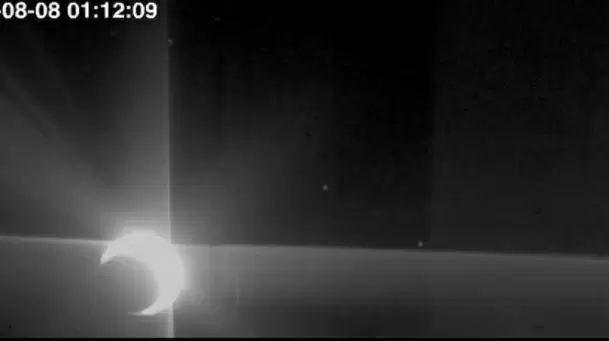Solar Orbiter-BepiColombo spacecraft capture Venus during flyby
Washington
13-August-2021

Photo:IANS
The Solar Orbiter Heliospheric Imager (SoloHI) telescope captured a gleaming view of Venus, during its recent flyby, NASA has said.
The images show Venus approaching from the left while the Sun is off camera to the upper right. The planet's nightside, the part hidden from the Sun, appears as a dark semicircle surrounded by a bright crescent of light -- glare from Venus' incredibly bright sunlit side.
"Ideally, we would have been able to resolve some features on the nightside of the planet, but there was just too much signal from the dayside," said Phillip Hess, astrophysicist at the Naval Research Laboratory in Washington, DC, in a statement.A
"Only a sliver of the dayside appears in the images, but it reflects enough sunlight to cause the bright crescent and the diffracted rays that seem to come from the surface," he added.
Two bright stars are also visible in the background early in the sequence, before being eclipsed by the planet. The rightmost is Omicron Tauri, and above and to the left of it is Xi Tauri, which is actually a quadruple star system. Both are part of the Taurus constellation.
This was Solar Orbiter's second Venus flyby, with an Earth flyby in November 2021 and six more Venus flybys planned from 2022 to 2030.
Watch This TWL Video
The spacecraft uses Venus' gravity to draw it closer to the Sun and tilt its orbit, swinging it up and out so as to "look down" on the Sun. From this vantage point, Solar Orbiter will eventually capture the first images of the Sun's north and south poles.
On August 10, just one day later, ESA and the Japan Aerospace Exploration Agency's BepiColombo mission also flew by Venus.
The monitoring cameras on board the BepiColombo mission to Mercury took a stunning sequence of 89 images, the ESA said in a statement.
The cameras took black-and-white snapshots in 1024 x 1024 pixel resolution. The high-gain antenna of the Mercury Planetary Orbiter and part of the body of the spacecraft are visible in front of Venus, the ESA said.-IANS
More Headlines
Row Over Aurangzeb's Tomb: Nagpur Flare-Up Occurred After Hours Of Mayhem In Mahal
Curfew Imposed in Nagpur After Clashes, 50 Detained
Manglam Group Invests ₹1,000 Crore in Hospitality Expansion Across Rajasthan
Chai Kings Secures ₹24 Crore Series A Funding from AVT for Expansion
Amritsar Temple Blast: One Suspect Shot Dead, Another on the Run
Row Over Aurangzeb's Tomb: Nagpur Flare-Up Occurred After Hours Of Mayhem In Mahal
Curfew Imposed in Nagpur After Clashes, 50 Detained
Manglam Group Invests ₹1,000 Crore in Hospitality Expansion Across Rajasthan
Chai Kings Secures ₹24 Crore Series A Funding from AVT for Expansion
Amritsar Temple Blast: One Suspect Shot Dead, Another on the Run










